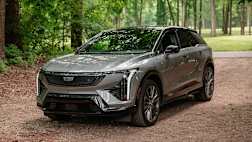Some time in the not-too-distant future, petrol-powered internal-combustion engines (ICE) will be something you’re more likely to find in a museum than an actual car, giving future-folk the chance to tut-tut and marvel in disbelief at how incredibly crude and environmentally unfriendly the past was.
In short, our cars will seem as absurd as penny farthings do to us today.
This scenario will be brought about by the eventual complete takeover of electric vehicles (EVs), whose planet-friendly motors have about half-a-dozen moving parts, as opposed to the hundreds you’ll find in an ICE. Fun fact: EVs have motors, not engines – the former refers to a machine that converts energy into mechanical energy, while the latter does the same thing, but while using thermal energy, ie combustion.
So if you use a term like “electric car’s engine”, back up and change it to something more along the lines of “electric vehicle motor”. You’ll look smarter, which is always something worth aiming for.
In general, motors for EVs work by converting electricity into mechanical energy through the creation of a magnetic field at the fixed part of the machine (the “stator”, which is static), whose displacement sets a rotating part (the “rotor”) in motion.
Motors used in electric cars
EVs use both Alternating Current (AC) and Direct Current (DC) motors, and there are several variations of each.
The electricity that EV batteries store is DC, so for EVs with AC motors, an inverter is required to convert the DC to AC so the energy that’s generated can do its job and power the car’s motor.
DC motor
Also known as a “brushed DC motor”, the advantage of this motor is its ability to produce high initial torque, while also offering easy speed control. A drawback, however, are the aforementioned brushes and the motor’s commutators, both of which require a higher degree of maintenance when compared to other motors. Another fun fact: forklift motors are DC and are usually the same as the ones you’d find in an electric car.
Brushless DC Motor (BLDC)
As you’d probably guess, these do away with the brushes, as well as the commutators, making them more technologically advanced and much lower maintenance. They’re efficient and offer high starting torque, and are widely used as wheel motors or “hub motors”, meaning they’re incorporated into the hub of a wheel, which it drives directly.
Permanent Magnet Synchronous Motor (PMSM)
Similar to a BLDC, but the PMSM has – as you’d guess from the name – permanent magnets embedded in the rotor to create a constant magnetic field. They have a high power rating and can be used in high-performance applications such as sports cars. These are the motors you’ll find in the Tesla Model 3 (although Tesla uses AC motors in other models, like the Tesla Model S).
![Tesla Model 3 has a Permanent Magnet Synchronous Motor.]() Tesla Model 3 has a Permanent Magnet Synchronous Motor.
Tesla Model 3 has a Permanent Magnet Synchronous Motor.
.jpg)
AC motors
There are two types of AC motors used in EVs: synchronous and asynchronous. Both types can work in reverse and convert mechanical energy into electricity that can be stored in the EV’s battery during deceleration, a nifty process commonly called “regenerative braking”.
In an asynchronous motor, also called an induction motor, the electric-powered stator generates a rotating magnetic field. In a synchronous motor, the rotor acts as an electromagnet itself.
Induction motors don’t have a high starting torque, but are efficient and cheaper when compared to other options.
In terms of use, a synchronous motor is seen as the better option for urban driving where there can be a lot of starting and stopping at low speeds, whereas an asynchronous motor is preferable for driving at high speeds for long periods of time.
AC motors are more widely used than DC motors due to the fact they are cheaper and more efficient, and are the choice of most major EV manufacturers, including Tesla and China’s largest car manufacturer, Great Wall Motors.
Electric powertrain
In an EV, the motor (rotor plus stator) is part of a system called the “electric powertrain”, which makes the electric motor function.
Within this powertrain you’ll also find a Power Electronic Controller (PEC), which brings together the components that manage the charging of the battery and the motor’s power supply, and a gear motor, which adjusts the torque and speed of rotation transmitted by the motor to the wheels.
Advantages
Electric motors are typically over 95 per cent efficient while ICEs are well behind, typically being below 50 per cent efficient.
Other advantages of electric motors include the fact that they’re smaller and lighter, cheaper to produce, can provide instant and consistent torque at any speed and have far less moving parts than an ICE, meaning they require very little in the way of regular maintenance.
The main advantage, though, is that they are far more environmentally friendly. EVs don’t release harmful emissions into the atmosphere and are capable of running on electricity generated by renewable sources, like wind and solar power, making them a far better option when it comes to planet-saving or, at the very least, planet-helping.






.jpg)
.jpg)

.jpg)

.jpg)

.jpg)
.jpg)




.jpg)



.jpg)